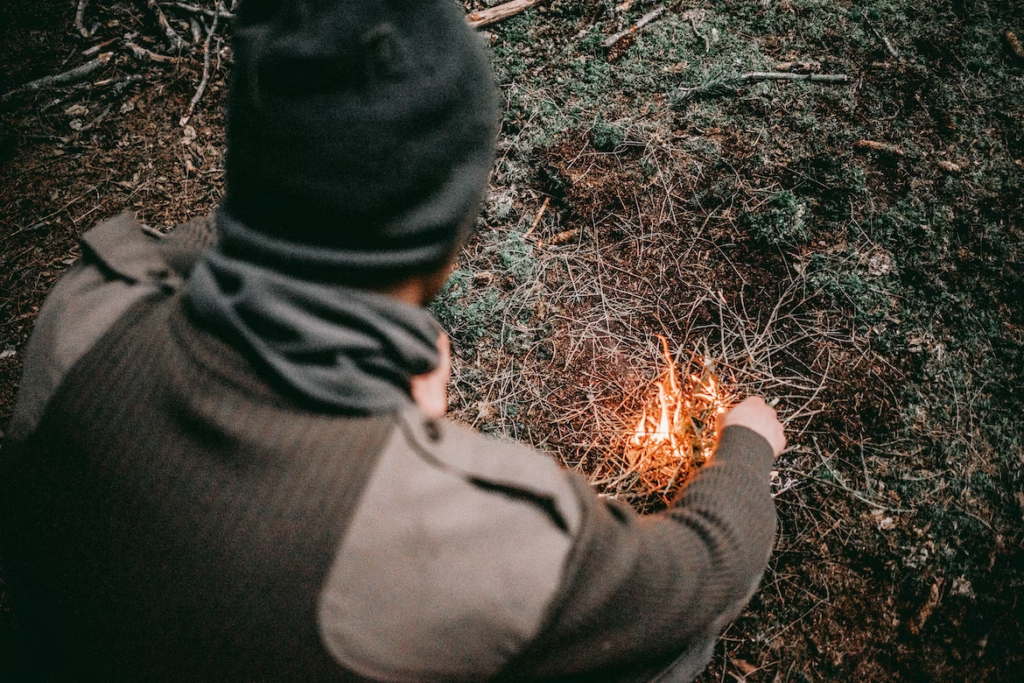Primitive Fire-Starting Manual
Introduction
Starting a fire without matches or a lighter is a fundamental survival skill. This manual guides you through various methods to start a primitive fire when lost. Fire is essential for warmth, cooking, water purification, and morale, making these techniques invaluable for anyone venturing into the wilderness.
Table of Contents
1. Understanding Fire Basics
2. Preparation
3. Methods of Primitive Fire Starting
– 3.1 Hand Drill
– 3.2 Bow Drill
– 3.3 Fire Plough
– 3.4 Flint and Steel
– 3.5 Solar Method
4. Building and Maintaining a Fire
5. Safety Considerations
6. Conclusion
1. Understanding Fire Basics
Fire requires three components:
– Fuel: Material that burns.
– Oxygen: Air to sustain the combustion.
– Heat: Energy to ignite the fuel.
2. Preparation
2.1 Selecting a Location
– Choose a safe and sheltered spot.
– Clear flammable materials from the area.
– Consider the wind direction.
2.2 Gathering Materials
– Tinder: Dry, finely shredded material that catches fire easily.
– Kindling: Small sticks and twigs.
– Fuel: Larger logs and branches.
3. Methods of Primitive Fire Starting
3.1 Hand Drill
The hand drill method requires a spindle and a fireboard.
1. Create a spindle: Find a straight, dry stick.
2. Create a fireboard: Find a flat piece of dry, softwood.
3. Create a depression: Carve a small hole in the fireboard.
4. Spin the spindle: Place the spindle into the depression and roll it between your palms.
5. Create an ember: Continue spinning until an ember forms.
6. *Transfer to tinder: Place the ember in tinder and gently blow to ignite.
3.2 Bow Drill
Similar to the hand drill but uses a bow to spin the spindle.
1. Create a bow: Find a strong, curved stick and attach a string or cord.
2. Assemble as in the hand drill method.
3. Use the bow: Hold the spindle with the bow, and move it back and forth to spin the spindle.
4. Follow steps 5-6 from the hand drill method.
3.3 Fire Plough
This method requires a plough and groove.
1. Create a plough: Find a harder stick or piece of wood.
2. Create a groove: Cut a groove in a softer piece of wood.
3. Plough: Run the plough along the groove until an ember forms.
4. Follow steps 5-6 from the hand drill method.
3.4 Flint and Steel
If you have steel and flint or a hard, sharp rock:
1. Strike together: Strike the steel against the flint to create sparks.
2. Catch the sparks: Direct the sparks onto the tinder.
3. Gently blow: Blow on the tinder until it ignites.
3.5 Solar Method
If it’s a sunny day and you have a magnifying glass or eyeglasses:
1. Angle towards the sun: Hold the glass so it focuses the sun’s rays onto the tinder.
2. Hold steady: Keep the focus until the tinder begins to smolder and then ignites.
4. Building and Maintaining a Fire
1. Add kindling: Once the tinder is lit, add kindling.
2. Add fuel: Gradually add larger pieces of wood.
3. Maintain: Keep the fire at a controlled size, adding fuel as needed.
5. Safety Considerations
– Never leave a fire unattended.
– Build a fire barrier, such as rocks, to contain the fire.
– Have water or sand nearby to extinguish the fire.
– Respect local fire restrictions.
6. Conclusion
Starting a fire using primitive methods is challenging but essential for survival in the wilderness. By understanding the basics of fire and practicing various techniques, you can enhance your skills and be prepared in any situation.
Remember, patience and persistence are often key when using these methods. Keep practicing and stay safe.

